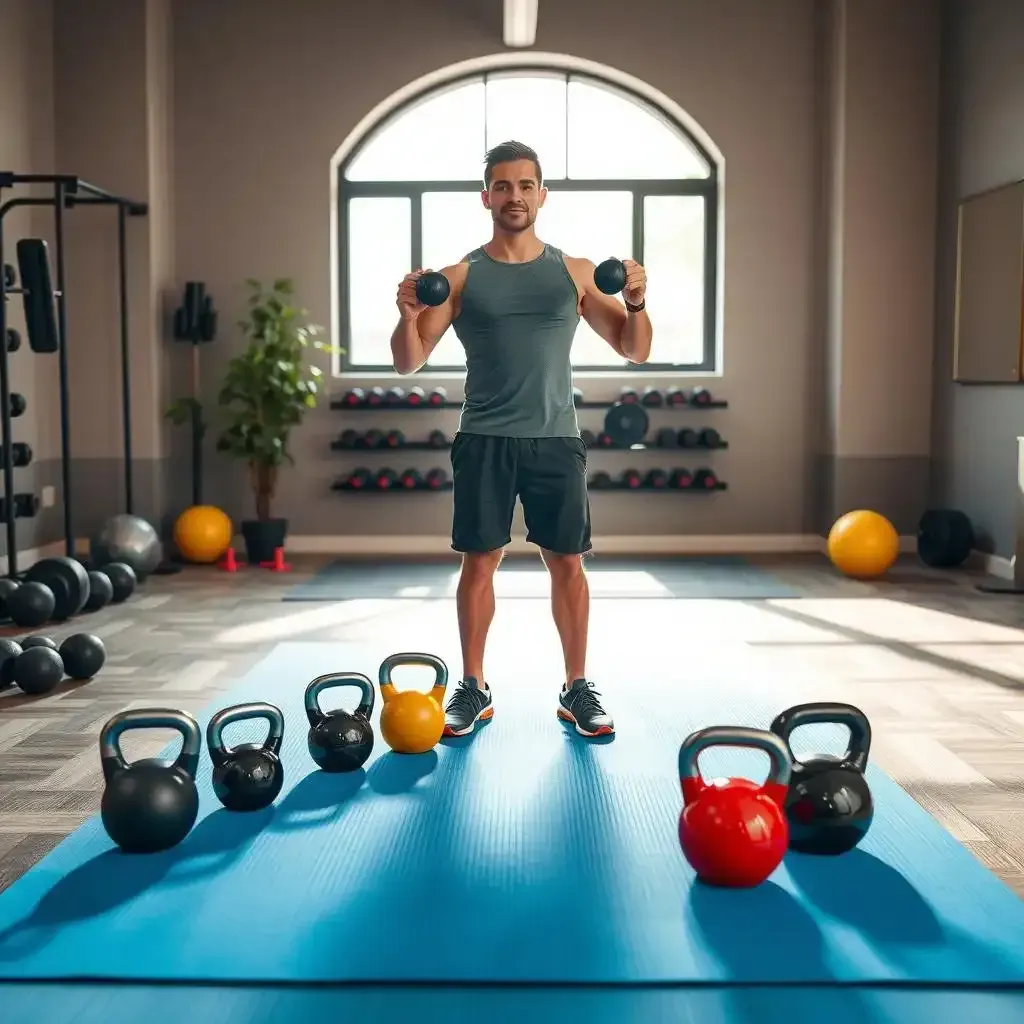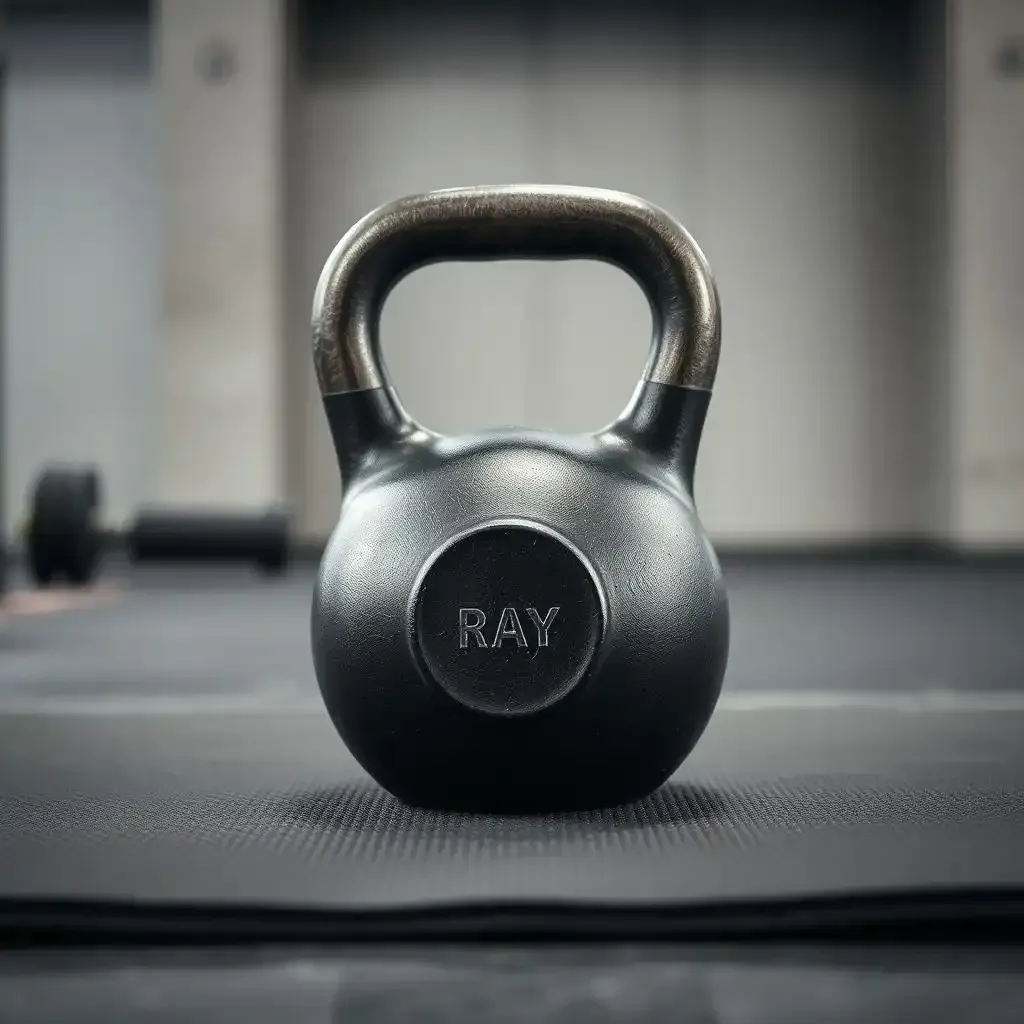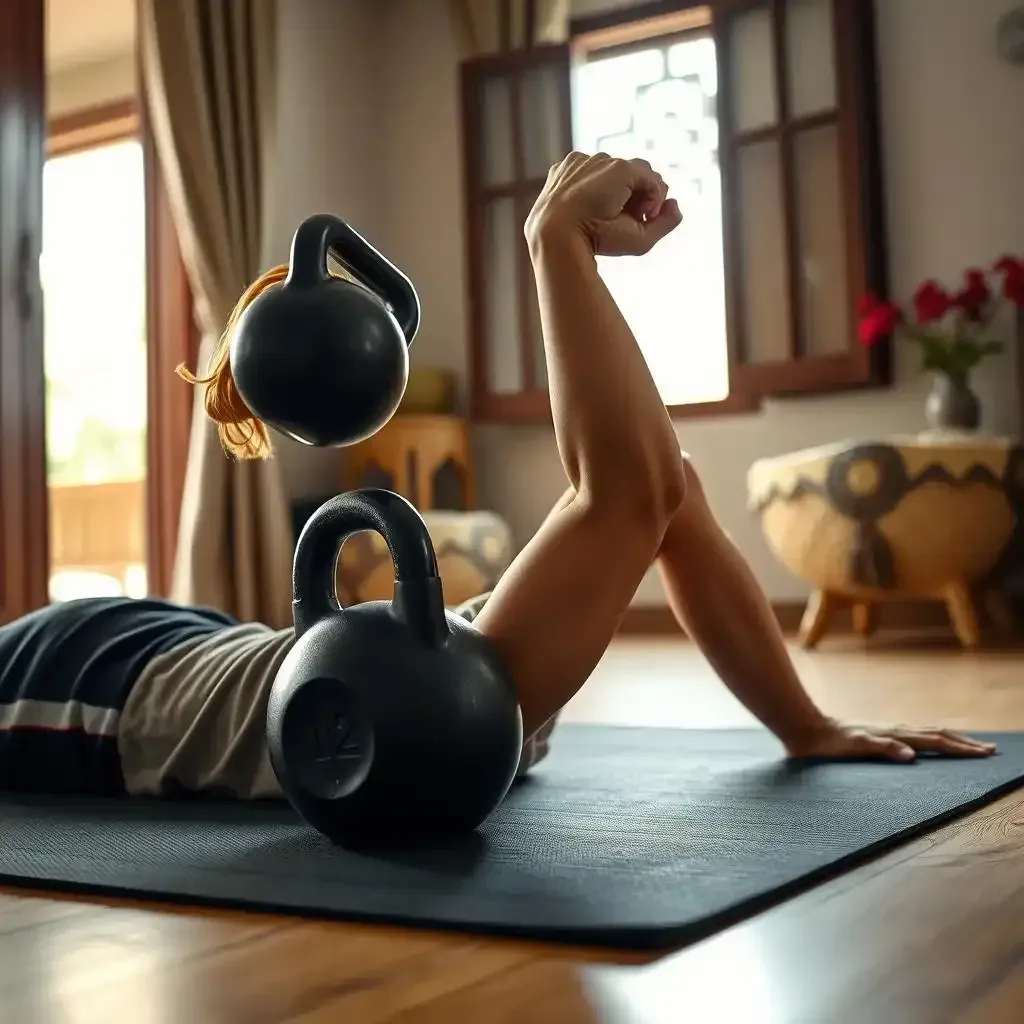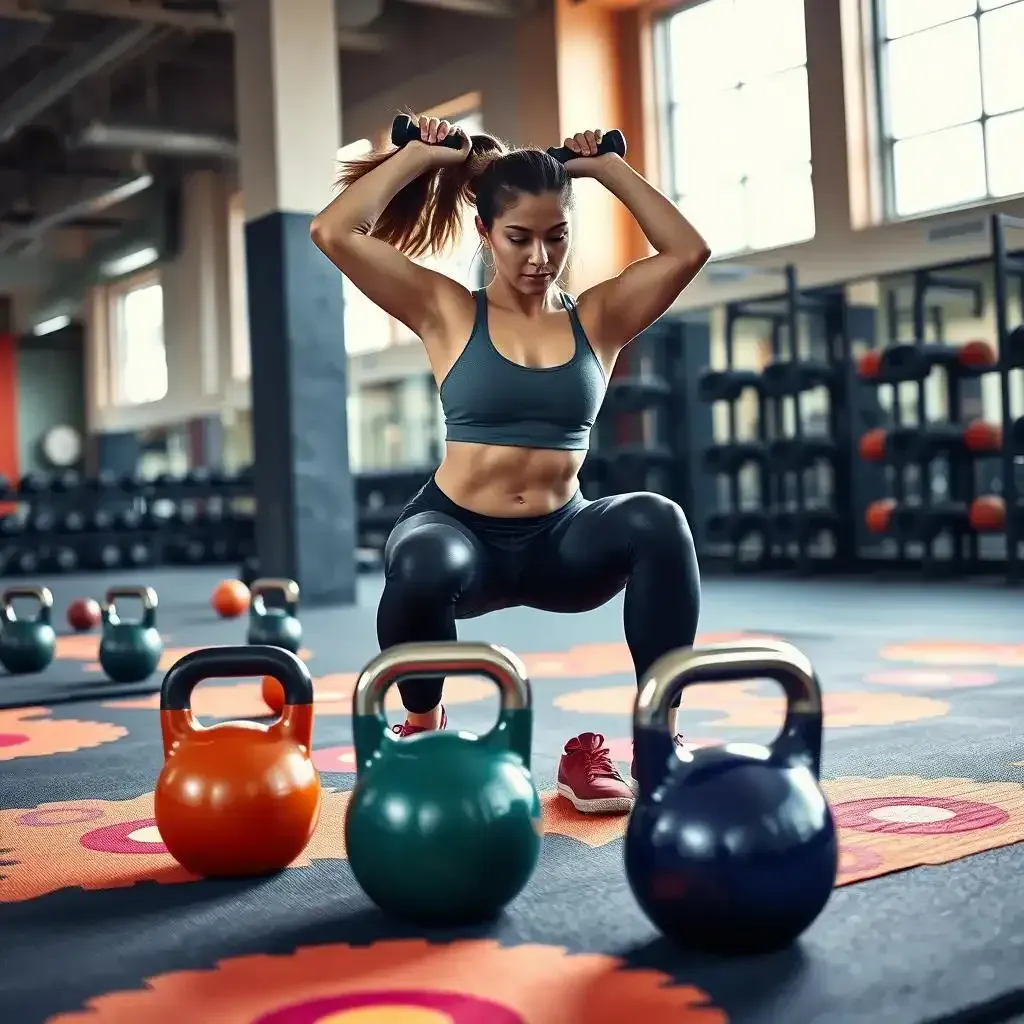Table of Contents
So, you're diving into the world of kettlebells? Awesome! But before you swing that iron beast around like a pro (or even a beginner!), let's talk about something crucial: your fitness mat. A good kettlebell with fitness mat setup isn't just about protecting your floors from those inevitable drops (trust me, they happen!). It's about comfort, safety, and actually enjoying your workout. Think of it as the unsung hero of your kettlebell process. We're going to explore everything you need to know to choose the perfect mat for your needs, whether you're a seasoned lifter setting up a home gym or a newbie just starting out. At kettlebellworkout.homes, we're all about making your kettlebell experience the best it can be, and finding the right mat is a huge part of that. Let's get started!
Choosing the Right Kettlebell Fitness Mat: Size and Thickness Matter

Choosing The Right Kettlebell Fitness Mat Size And Thickness Matter
Okay, let's talk mats! Picking the right one is like choosing the perfect comfy chair – you want something supportive and enjoyable, right? The size and thickness of your mat are super important, especially when you're dealing with kettlebells. They can get heavy, and you’ll be moving around, so you need a mat that's up to the task. Think of it like this: a thin, flimsy mat is like trying to do a handstand on a piece of paper – not ideal!
You want a mat that’s big enough to give you plenty of room to swing that kettlebell without bumping into anything. I learned this the hard way! My first mat was way too small, and I kept whacking my coffee table during Turkish get-ups. Ouch! A good rule of thumb is to get something at least 6x6 feet, maybe even bigger if you have the space. You'll thank me later. Also, think about the thickness. A thicker mat (at least 10mm) provides better cushioning and protection for your joints. Remember those tough kettlebell exercises? A thick mat makes a huge difference, especially on your knees and elbows. For more tips on kettlebell exercises check out our beginner kettlebell routine!
Mat Size | Thickness (mm) | Pros | Cons |
|---|---|---|---|
6x6 feet | 10mm | Plenty of space, good cushioning | Might be too big for small spaces |
4x6 feet | 15mm | Good compromise, extra cushioning | Less space for larger movements |
So, what's the perfect size and thickness for you? It really depends on your space and personal preference. If you're short on space, a smaller but thicker mat might be a better choice. But if you have a big workout area, go for the larger mat to give yourself plenty of room to move. Don't feel pressured to buy the most expensive mat either – a good quality mat doesn't have to break the bank!
I've tried a bunch of different mats, and I’ve found that the sweet spot is usually around a 10-15mm thickness, with a size of at least 6x6 feet. This provides a good balance between comfort, cushioning, and space. Now, let's talk about materials...because not all mats are created equal.
- Measure your workout space before buying a mat.
- Consider the thickness for joint protection.
- Think about the material for grip and durability.
Kettlebell Mat Materials: Rubber, Foam, and Beyond
Now that we've covered size and thickness, let's investigate into the world of kettlebell mat materials! It's like choosing the perfect pair of shoes – the right material makes all the difference. You wouldn’t run a marathon in flip-flops, would you? Similarly, you don't want a flimsy mat sliding around under your kettlebells during a tough workout. You need something durable, grippy, and comfortable.
Rubber mats are usually the top choice for serious kettlebell training. They're super durable, provide excellent grip, and can withstand a lot of abuse. They're like the tough guys of the mat world—reliable and ready for anything. They also tend to be a bit heavier, which means they're less likely to slip and slide around during your workouts. I once had a foam mat that was so flimsy, it felt like I was working out on a cloud—not very stable! Rubber mats are much more stable and secure.
For more info on getting started with kettlebells, check out our kettlebell basics guide!
Foam mats are a good alternative, especially if you’re on a budget. They’re lighter and often more affordable than rubber mats. However, they don't offer the same level of durability or grip. They're a good option if you’re doing lighter kettlebell work or if you have some other type of flooring to add support. They're like the friendly neighborhood mats – good for a casual workout, but not for intense training sessions. But remember, a good grip is crucial for safety, so you might want to consider a rubber mat for more intense exercises.
Want to learn some easy kettlebell exercises? Check out our easy kettlebell exercises post!
"The right mat is like having a trusty sidekick during your kettlebell trip. It's not glamorous, but it's essential!" - Your Name
Protecting Your Floors and Body with a Kettlebell Mat: A Home Gym Essential
Okay, let's be honest, kettlebells and hard floors don't mix well. Dropping a heavy kettlebell on your hardwood floor is a recipe for disaster – both for your floor and your ears! That’s why a fitness mat is an absolute must-have, especially if you're working out at home. It protects your floors from scratches and dents, and it makes a huge difference in reducing noise. No more angry neighbors complaining about the clanging!
But it's not just about protecting your floors; a mat also protects *you*. It provides cushioning during floor exercises like squats and lunges, reducing stress on your joints. It's like giving your body a little extra layer of protection against impact, which is especially helpful during those high-intensity kettlebell workouts. I've seen people skip the mat, and trust me, it’s not worth it. Your knees and elbows will thank you for having a mat. Check out our kettlebell injury prevention tips for more info!
- Protects your floor from damage.
- Reduces noise during workouts.
- Cushions your joints during floor exercises.
Think of your mat as a personal safety net, providing both comfort and protection during your kettlebell sessions. It's a small investment that pays off big time in the long run, keeping your floors and your body happy and healthy. It's a small price to pay for a safer and more enjoyable workout!
Want to know more about building a home gym? Read our guide on kettlebell exercises for home!
Finding the Perfect Kettlebell and Mat Combo for Your Workout
Picking the perfect kettlebell and mat combo is like finding the perfect dance partner – it takes a bit of thought and consideration, but when you find the right match, it feels amazing! You need a combo that works for your body type, workout style, and space. Don't just grab the first kettlebell and mat you see. Take your time, do your research, and find the perfect pair for your kettlebell trip.
Start by considering your workout goals. Are you focused on strength training, cardio, or a combination of both? Different kettlebell exercises require different levels of space and support, so your mat choice should reflect that. If you're doing a lot of floor work, you'll want a thicker mat. If you’re focusing on swings and cleans, you might prioritize a larger mat to give yourself plenty of room to move. If you are just starting out, you might find our kettlebell guide for newbies helpful!
Next, think about the weight of your kettlebells. Heavier kettlebells require a mat that can handle the extra weight and impact. A good quality, heavier rubber mat is your best bet in this case. And of course, don't forget about your space! If you have a small workout area, you'll need a mat that's compact but still provides adequate cushioning and support. Consider your personal preferences as well – are you more comfortable with a soft, cushioned mat, or do you prefer a firmer mat with more grip?
For more advanced kettlebell routines, check out our advanced kettlebell routines page!
Kettlebell Mat Materials: Rubber, Foam, and Beyond

Kettlebell Mat Materials Rubber Foam And Beyond
Now that we've covered size and thickness, let's talk about the materials that make your kettlebell mat. It’s like choosing the perfect pair of shoes – the right material makes all the difference. You wouldn’t run a marathon in flip-flops, would you? Similarly, you don't want a flimsy mat sliding around under your kettlebells during a tough workout. You need something durable, grippy, and comfortable.
Rubber mats are usually the top choice for serious kettlebell training. They're super durable, provide excellent grip, and can withstand a lot of abuse. They're like the tough guys of the mat world—reliable and ready for anything. They also tend to be a bit heavier, which means they’re less likely to slip and slide around during your workouts. I once had a foam mat that was so flimsy, it felt like I was working out on a cloud—not very stable! Rubber mats are much more stable and secure.
Material | Pros | Cons |
|---|---|---|
Rubber | Durable, excellent grip, heavy | Heavier and more expensive |
Foam | Lightweight, affordable, soft | Less durable, less grip |
For more info on getting started with kettlebells, check out our !
Foam mats are a good alternative, especially if you’re on a budget. They’re lighter and often more affordable than rubber mats. However, they don't offer the same level of durability or grip. They’re a good option if you’re doing lighter kettlebell work or if you have some other type of flooring to add support. They’re like the friendly neighborhood mats – good for a casual workout, but not for intense training sessions. But remember, a good grip is crucial for safety, so you might want to consider a rubber mat for more intense exercises.
"The right mat is like having a trusty sidekick during your kettlebell trip. It’s not glamorous, but it’s essential!" - Your Name
Want to learn some easy kettlebell exercises? Check out our post!
Protecting Your Floors and Body with a Kettlebell Mat: A Home Gym Essential

Protecting Your Floors And Body With A Kettlebell Mat A Home Gym Essential
Okay, visualize this: you're mid-kettlebell swing, feeling strong, then BAM! You drop the weight. Without a mat, that's a recipe for disaster – a dented floor and possibly a bruised ego. That's why a mat isn't just a nice-to-have; it's a must-have, especially if you're working out at home. It's like giving your floors a superhero cape – protecting them from scratches, dents, and all those noisy drops. Say goodbye to angry neighbors complaining about the clanging of metal on hardwood!
But it’s not just about saving your floors; a mat is your body's best friend too. It’s like a comfy cushion for your joints during those floor exercises. Think of those brutal Turkish get-ups; a good mat makes a world of difference on your knees and elbows. I remember once trying to do squats without a mat – my knees were screaming for mercy by the third rep! A mat acts as a shock absorber, reducing stress on your joints and making your workouts far more enjoyable. For more tips on keeping your body happy, check out our guide!
Mat Feature | Benefit | Why it matters |
|---|---|---|
Floor Protection | Prevents scratches and dents | Keeps your floors looking good |
Joint Cushioning | Reduces stress on knees, elbows, etc. | Makes workouts more comfortable and safer |
Noise Reduction | Quiets the clanging of kettlebells | Keeps the peace with your neighbors |
Seriously, a mat is your silent partner in crime, providing both comfort and protection during your kettlebell trip. It's a small investment that pays off big time in the long run, keeping both your floors and your body happy. It's a small price to pay for a safer and more enjoyable workout, and trust me – your body will thank you for it!
Want to learn more about setting up your home gym? Check out our !
- Think of your mat as your workout buddy.
- It's all about protection and comfort.
- A small investment for big returns!
Finding the Perfect Kettlebell and Mat Combo for Your Workout

Finding The Perfect Kettlebell And Mat Combo For Your Workout
Picking the perfect kettlebell and mat combo is like finding the perfect dance partner – it takes a bit of thought and consideration, but when you find the right match, it feels amazing! You need a combo that works for your body type, workout style, and space. Don't just grab the first kettlebell and mat you see. Take your time, do your research, and find the perfect pair for your kettlebell trip.
Start by considering your workout goals. Are you focused on strength training, cardio, or a combination of both? Different kettlebell exercises require different levels of space and support, so your mat choice should reflect that. If you're doing a lot of floor work, you'll want a thicker mat. If you’re focusing on swings and cleans, you might prioritize a larger mat to give yourself plenty of room to move. If you are just starting out, you might find our helpful!
Workout Goal | Mat Size | Mat Thickness |
|---|---|---|
Strength Training | 6x6 feet | 15mm |
Cardio | 4x8 feet | 10mm |
Next, think about the weight of your kettlebells. Heavier kettlebells require a mat that can handle the extra weight and impact. A good quality, heavier rubber mat is your best bet in this case. And of course, don't forget about your space! If you have a small workout area, you'll need a mat that's compact but still provides adequate cushioning and support. Consider your personal preferences as well – are you more comfortable with a soft, cushioned mat, or do you prefer a firmer mat with more grip?
For more advanced kettlebell routines, check out our page!
- Consider your workout goals.
- Think about the weight of your kettlebells.
- Match your mat to your available space.
The right combination can make your workouts more enjoyable and effective. It’s like getting the right tools for a job – you wouldn’t use a screwdriver to hammer a nail, would you? The same goes for your kettlebell and mat. Find what works best for you, and you’ll be on your way to a stronger, healthier you in no time!
Final Thought
Finding the right kettlebell with fitness mat combination is a game-changer for your workouts. It's about investing in your comfort, safety, and the longevity of your training. Remember to consider your space, workout style, and budget when making your choice. Happy lifting!